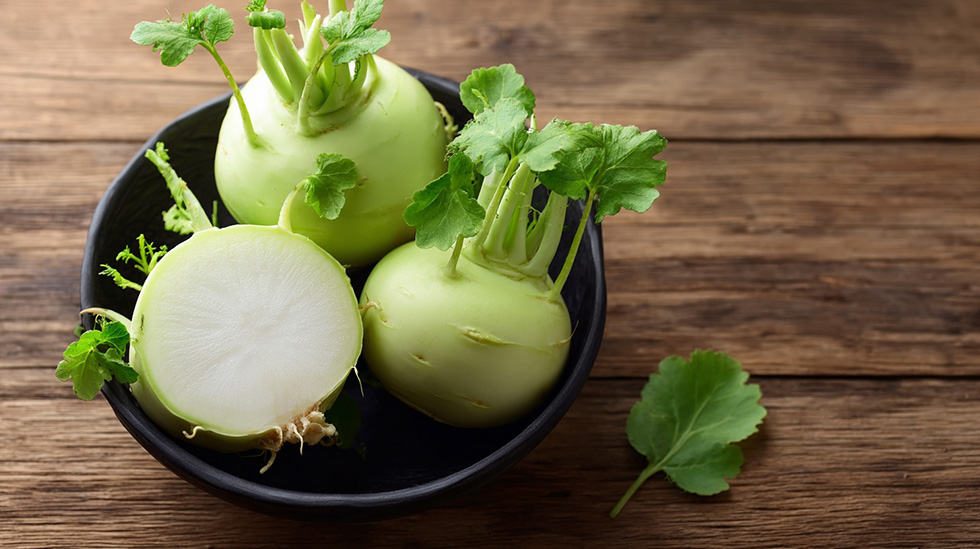Kohlrabi: one of the cutest vegetables in the kitchen 🥰
The kohlrabi (Latin: Brassica oleracea var. gongylodes ) is a real speciality of the cabbage family. In Hungarian it is also known as tarlórépa, although this is less common nowadays. The plant is native to Europe and was probably eaten in the Middle Ages. The first written record of it dates back to the 16th century, and it has not lost its popularity – in fact, more and more people are rediscovering this versatile, fun-looking vegetable.

How important is it in the kitchen?
Rating: 4/5
The kohlrabi is not the biggest star like tomatoes or peppers, but it is a reliable and versatile vegetable. It’s great in soups, stews, stews, grilled or even raw. It may be a little underrated in Hungarian cuisine, but once you fall in love with it, it’s not easy to let go.
Which part is edible?
The most delicious part of the kohlrabi is the thickened stem – the spherical, tender ‘tuber’ most of us know as the kohlrabi. It’s great raw or cooked. The young leaves are also edible and can be made into stews or salads – if they are nice and fresh.
What’s not recommended: avoid the hard parts of woody, overripe kohlrabi, because they are stringy, unpalatable and your stomach won’t like them. There are no poisonous parts, but as with all vegetables, it is not recommended to eat the rotten ones.
Health benefits 💪
Kohlrabi is packed with vitamin C – even a small head can provide your daily requirement. It also contains:
- Potassium – the heart-healthy mineral
- Fibre – aids digestion
- Folic acid – especially important for pregnant women
- Antioxidants – help protect your cells
According to folk medicine, it aids digestion, reduces bloating and has a positive effect on blood sugar levels. It is low in calories, making it an ideal companion for dieters!
Specificities of its production
Kohlrabi is grown in many countries in Europe, mainly in the open air. In Hungary, you can find it from spring to autumn, but early (primary) varieties are available from the end of March, while late varieties for storage are available even in winter.
Its main producers are Germany and Poland, but Hungary also exports a good amount. Hungarian produce is most commonly found on the shelves of Hungarian shops from April to November, while imported kohlrabi is the most common product during the winter months.
How to choose a good kohlrabi 🛒
Choosing a good kohlrabi is not a fool’s errand, just pay attention to the following:
- Be hard, solid to the touch
- Don’t be cracked, frayed, soft
- The skin should be smooth, pale green or purple (depending on the variety)
- The freshness of the leaves is also telling: if they are still on, they should not be yellowish or wilted
Avoid large, “overfed” specimens – they are often woody inside.
How do we store it?
It will keep for 1-2 weeks in the refrigerator or vegetable storage compartment. If you buy it for longer, it’s a good idea to remove the leaves, as they deteriorate more quickly and extract moisture from the tuber. The kohlrabi also freezes well – peel, dice and blanch it in the freezer!
Kohlrabies in the kitchens of the world 🌍
Kohlrabi is known worldwide, but it is not used in the same way everywhere:
- In Germany, often served steamed with butter as a side dish
- Cooked in India as a spicy curry, with leaves
- Cooked in a wok in China with other vegetables
- In France, it is also used to make a creamy kohlrabi gratin
So if you thought it was just for soup, it’s time to rethink! 😉
Best-known recipe: stuffed kohlrabi
A favourite of Hungarian housewives: stuffed kohlrabi.
Hollow out the inside of the kohlrabi, stuff with minced meat and rice, then cook in sour cream and dill. The flavour is creamy, smooth and at the same time cosy and special – worth a try!
Kitchen tips: what to do with it?
Kohlrabi is excellent raw, cooked, steamed, baked and grilled. It can be prepared:
- Soup (also fantastic as a cream soup)
- Main course
- Grilled vegetable side dish
- Vegetable hash browns or chips
It looks good with spices:
- Kapor
- Parsley
- Speech from
- Garlic
- Cumin
Avoid spices with too much character, such as curry or cinnamon – these will overpower the specific, slightly sweet taste of kohlrabi.
Final thought
Not only is kohlrabi healthy, it’s also super versatile! If you haven’t kept it as a regular in your kitchen, it’s time to give it a new chance – it’s surprisingly good on all fronts. Next time you’re at the market, feel free to reach for a round, tender one! 😊
